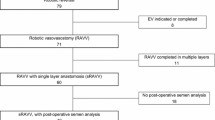Abstract
Vasovasostomy (VV) for iatrogenic infertility is commonly employed for patients with obstructive intervals of less than 15 years, with the microsurgical technique gaining favor over use of loupe magnification due to precision suture placement. We present our technique of a robot-assisted VV and compare surgical times of staff to resident. Twenty patients with iatrogenic infertility and obstructed intervals of less than 10 years underwent robot-assisted VV, 17 utilizing a single-layer reapproximation and 3 using a double-layer reapproximation. Average patient age was 32.9 years. Following vasal exposure, the staff performed the robot-assisted anastomosis on one side followed by the resident on the opposite side. Reanastomosis times and semen analyses were recorded. Twenty patients underwent successful single- or double-layer robot-assisted vasovasostomy. Mean console time for staff to complete the vasal reconstruction was 37.6 min compared to the resident time of 54 min. Mean total operative time for all procedures was 187 min (single-layer procedure averaged 182 min compared to double-layer repair which averaged 238 min). Thirteen patients returned for follow-up semen analysis, with twelve patients demonstrating sperm within the ejaculate. Additionally, two patients reported pregnancies for a patency rate of 93%. Mean sperm density was 14 million/ml with motility of 26.4%. Robot-assisted vasovasostomy is a technically feasible procedure demonstrating adequate results on follow-up semen analysis, and can be included in training residents in robotic surgery. Additional data are needed to determine its role in the management of iatrogenic infertility.




Similar content being viewed by others
References
Kuang W, Shin PR, Surena M et al (2004) Initial evaluation of robotic technology for microsurgical vasovasostomy. J Urol 171(1):300–303
Belker AM, Thomas AJ, Fuchs EF, Konnak JW, Sharlip ID (1991) Results of the 1469 microsurgical vasectomy reversals by the vasovasostomy study group. J Urol 145:505
Schiff J, Li PS, Goldstein M (2004) Robotic microsurgical vasovasostomy and vasoepididymostomy: a prospective randomized study in a rat model. J Urol 171(4):1720–1725
Fuse H, Kimura H, Katayama T (1995) Modified one-layer microscurgical vasovasostomy in vasectomized patients. Int Urol Nephrol 27(4):451–456
Jee SH, Young KH (2010) One-layer vasovasostomy: microsurgical versus loupe-assisted. Fertil Steril 94(6):2308–2311
Fleming C (2004) Robotic-assisted vasovasostomy. Urol Clin N Am 31:769–772
Nagler HM, Jung H (2009) Factors predicting successful microsurgical vasectomy reversal. Urol Clin N Am 36:383–390
Lipshultz LI, Rumohr JA, Bennett RC (2009) Techniques for vasectomy reversal. Urol Clin N Am 36:375–382
Conflict of interest
None.
Author information
Authors and Affiliations
Corresponding author
Additional information
Disclaimer: The views expressed in this article are those of the authors and do not reflect the official policy or position of the Department of the Navy, Department of Defense, or the United States Government.
Rights and permissions
About this article
Cite this article
Santomauro, M.G., Choe, C.H., L’Esperance, J.O. et al. Robotic vasovasostomy: description of technique and review of initial results. J Robotic Surg 6, 217–221 (2012). https://doi.org/10.1007/s11701-011-0295-2
Received:
Accepted:
Published:
Issue Date:
DOI: https://doi.org/10.1007/s11701-011-0295-2




